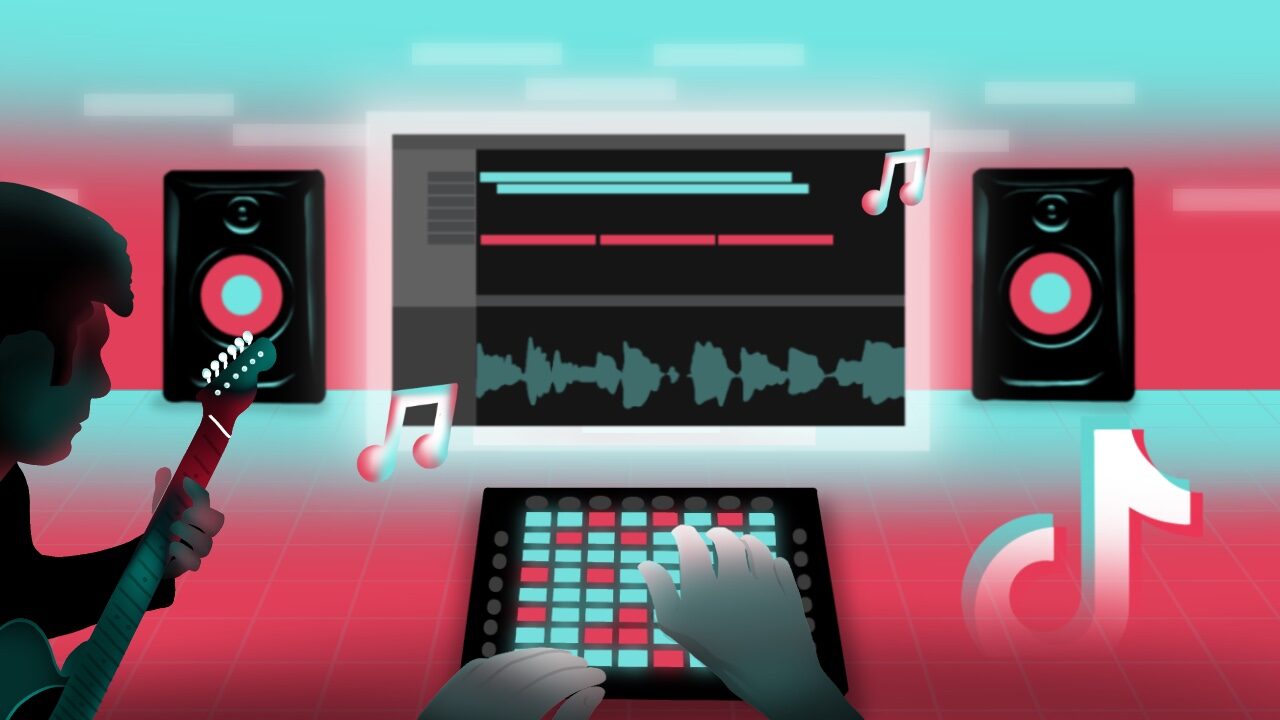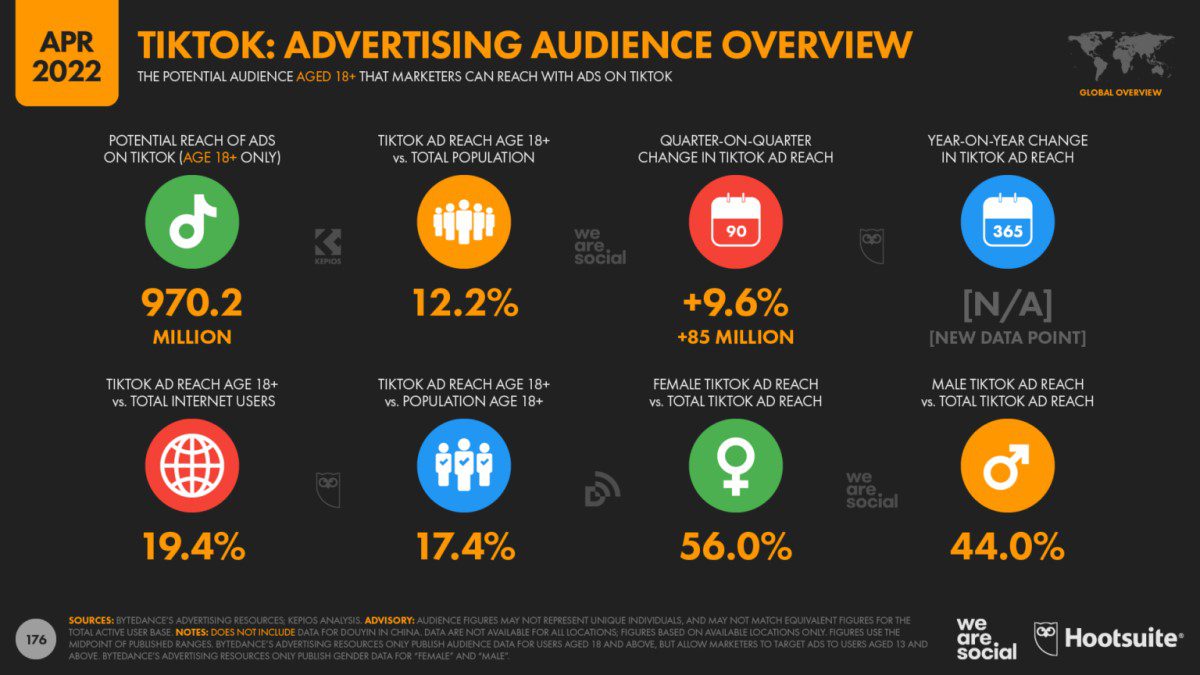
A musician guide to TikTok: Introduction (1/2)
Spotlight on TikTok
A little history
TikTok was launched in 2016 by the Chinese company Byte Dance, itself created in 2012 in Beijing. Then its boss, Zhang Yiming, bought the playback app Musical.ly for $800M in late 2017 and merged it with TikTok. An immediate hit in China, the app exploded in the US in late 2018 before starting to buzz in late 2019 in Europe. Its lightning success made it the 3rd largest social network in the world last year, just behind Facebook and Instagram, with over 750 million monthly users (according to InsiderIntelligence.com).
Massive usage
In 2022, while the growth of other social networks is plateauing, TikTok is breaking records. According to the annual study by We Are Social and Hootsuite, in the first quarter of 2022, TikTok’s advertising audience reached 970 million users aged 18 and older, up 9.6 % with 85 million new subscribers in the period. That’s the equivalent of one million additional users per day! In these first three months of the year, $620 million was spent on the app in tips to creators. “This is the largest amount ever earned by a mobile app in a single quarter from end consumer spending (…). These figures do not include traditional ad spend, social commerce transactions, or marketing deals between brands and influencers.”

Music at the center
According to the IFPI, in France 55% of 16-19 year olds said they use TikTok daily, for an average of 1.5 hours per week. But among the over 55s, more than one in 10 people regularly use the app. Above all, 69% of the time spent on TikTok concerns musical content and 77% of users discover artists and music tracks. More generally, 19% of French people discover music via TikTok, and even 46% of 16-24 year olds. Not surprising since it is often the soundtrack of videos that allows creators to distinguish themselves.
How it works
Short videos
TikTok is an application of short and viral videos created by the users themselves. We talk about User Generated Content (UGC). Initially limited to 15 seconds, the videos quickly became longer. Today, TikTok is stepping on the toes of YouTube, the main platform for long format videos, with a duration of up to 10 minutes (YouTube is also encroaching on TikTok’s territory with its YouTube shorts).
However, it is still recommended to propose videos between 15 and 30 seconds, to stay on the star format of TikTok. Some media videos go up to 3 minutes. It works, as for Pan African Music, IDOL’s Afro media, whose videos last between 2 and 5 minutes, with a majority of the audience watching up to 50% of the content, which is a good score. Today all formats are mixing: TikTok in short, YouTube in long and Twitch in Live.
The right “CUT”
It is important to determine the good extract of a song to position on a video, to guarantee a maximum virality. IDOL accompanies its labels to isolate as well as possible this “cut” of 1 minute. The distributor then delivers the labels’ catalog of cuts, via its Labelcamp solution.
The central role of users on TikTok empowers artists. IDOL is the catalyst for this by bridging the gap with TikTok. It provides its labels with the Labelcamp tool.
A blog updates the best practices on a regular basis.
A daily form also lists the operations launched by TikTok on certain hashtags, so that artists can surf on these trends.
Finally, there are guides for creating videos depending on where the artist is: in the studio, in a promo, in concert. This is valid for TikTok, but also Snapchat, YouTube shorts, Triller, etc.
How much time can I spend on TikTok?
There is no limit! Both on the time spent, and on the number of daily posts. The ephemeral nature of the videos encourages you not to limit yourself, unlike other platforms. On TikTok, making ten videos in a day, even if they fail, is not a problem.
Since posts can take a while to go viral, you have to give yourself time to analyze the results. At IDOL, there is no artist who has scattered on TikTok. On the contrary, we find very good students. If the artist follows all the recommendations, tags his music well, goes as far as noting the chords of his song in the video, he can create a real engagement of his audience by soliciting them directly: “take my song, add the bass, the sax, etc.”
How does the algorithm work?
Because TikTok doesn’t offer suggestions based on the accounts users follow, reading its algorithm is complex, sometimes even on TikTok’s end. The process consists in suggesting a title to a first circle of users. Either the title progresses to larger circles, or it stumbles on a low engagement and a high skip rate (the act of moving to the next content). To avoid this second case and to progress towards more and more users, you have to be active and up to date.
Pace your video well
This is what differentiates TikTok from Instagram, where the number of subscribers and the number of accounts followed is decisive. A content that does not take is much less penalizing. It is the quantity of posts that pays on TikTok to get organic results.
Moreover, as long as the user does not move on to the next content, the video is looping. Therefore, you need to place a catchy snippet at the beginning to encourage the user to watch to the end in order to revisit that part from the beginning. Placing the song’s hook (its distinctive melodic element) at the beginning of the video is a good bait. The first few seconds are crucial.
To follow
A musician guide to TikTok #2 Strategy